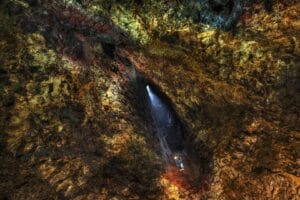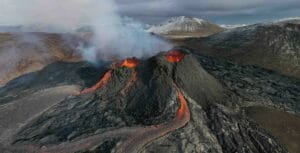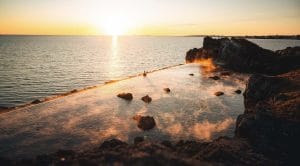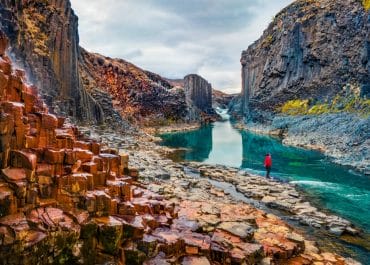Every time one thinks of going on a vacation the first thing one does is check out the most popular places, events, traditions, and culture of the place in mind. This is something that every tourist does to gather important information about a place to make a firm decision. In Iceland’s case, the places that grab the attention of tourists are the Blue Lagoon, the Golden Circle, the Diamond circle, the capital city of Reykjavik, Akureyri – the capital in the north, black sand beaches of the south coast, the highlands, the fiery volcanoes, and the magnificent glaciers. While one can get to know about all the most-visited and the most popular places in the country by a little bit of research, the hidden gems which are more like secret beautiful hideouts in a country often go unnoticed. Less traveled in general and known by a few, there are amazing places in the land of ice and fire, camouflaged smartly and hidden in the most unlikely of the places. This article will discuss the various hidden gems of Iceland which are top-secret and every bit worth paying a visit.

Best Secret Locations in Iceland
There are tons of places you can visit in the land of ice and fire, but visiting a place that has not seen a lot of guests because they are not only lesser-known but also quite tricky to reach. This fact alone increases the excitement level several folds for the ones who love adventure and are always on the lookout for the thrill. So, let’s explore some of the best secret, hidden locations in Iceland.
Loftsalahellir Cave

Located opposite to once an island and now a peninsula – Dyrhólaós, Loftsalahellir cave is quite an unusual cave made of a hole in a turf rock. The exact location of this cave is on the southwest side of the Geitafjall mountain. There are a variety of basalt formations in this area accompanied by some very lush green vegetation. Traditionally, this cave used to serve as a meeting point for the farmers and fishermen from the surrounding areas like Vik village to hold assemblies. This rock was also known as Gálgaklettur which translates to “gallows rock”. The name may be an indication that the rock was used as a place for the execution of criminals but there are no documented proofs for that notion. Even if alleged, this particular notion makes this hidden spot a pretty interesting place to visit.
You will find it pretty hard to notice the cave upon arriving at the spot. Looking for a huge turf rock may do the trick. This turf rock is the only one stranded in the plane making it quite easy to spot it. The cave is at the bottom of this oddly shaped rock. The surrounding landscape makes this a pretty great place to get amazing pictures for social media and photo albums. You can follow the coordinates given below to get to the spot.
Sigoldugljufur – The Valley of Tears
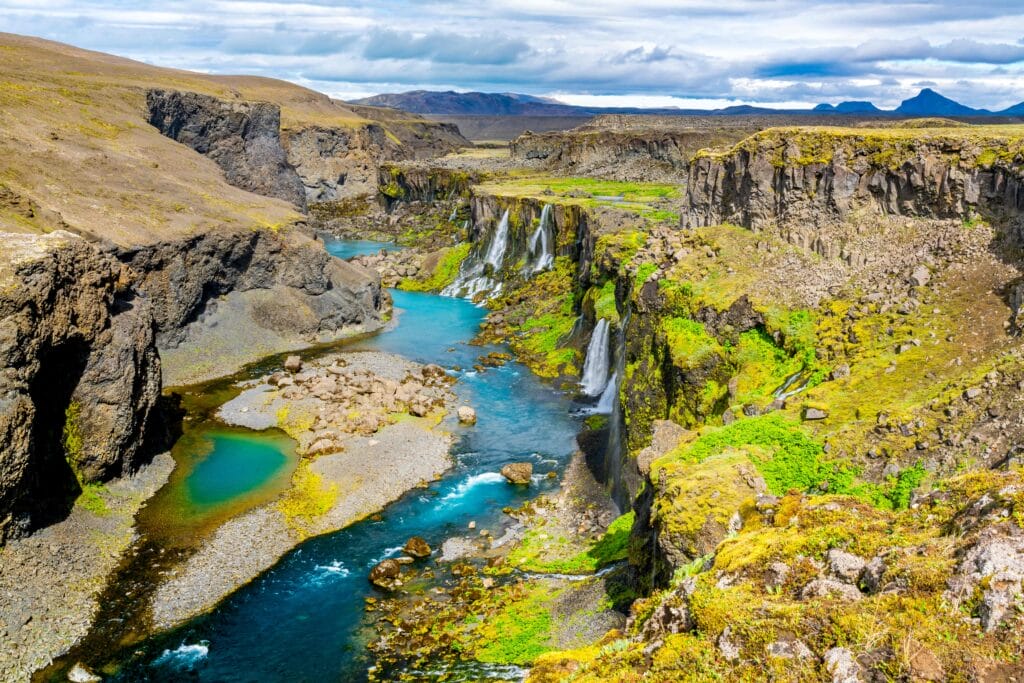
A canyon located in the highlands of Iceland, Sigoldugljufur canyon is known for the exceptionally beautiful sights that it holds, along with a huge number of waterfalls, lava landscapes, and lush green vegetation. Although the Sigoldugljufur canyon is not as large as many other canyons in the country, it is still very attention-grabbing because of the heavenly oasis-like beauty that it flaunts. The canyon is located to the north of Fjallabak Nature Reserve which is popular for housing the most popular hiking trail of the country Landmannalaugar to Þórsmörk, several hot springs, and mountain ranges.
An interesting fact about Sigoldugljufur is that it was not always a canyon, to begin with. Sigoldugljufur was used to be filled with water coming from the Tungnaá river until the Sigala hydroelectric station was built. This changed the geology of the area and turned Sigoldugljufur into a canyon. This plant is responsible for providing 70% of the renewable energy used in Iceland. Reaching the valley will require you to take a short hike along with a 2-and-a-half-hour drive. Be prepared to come face to face with a lot of waterfalls filled with bright blue water along with beautiful landscapes. The following are the coordinates to the canyon.
Strútsfoss waterfall
Even though it is one of the tallest waterfalls in Iceland, Strútsfoss is one of the lesser-known waterfalls in Iceland simply because its location is a bit off the road and craftily hidden in a side valley. It is located quite close to the better-known Hengifoss waterfall and shares the same kind of distinct lava-layer look as Hengifoss. If one is not familiar with the existence of both these waterfalls, it is very likely to confuse them with each other. Strútsfoss gets fed by the river Strútsá and falls into the Suðurdalur valley. The waterfall is divided into two parts where the upper portion has a fall of 20 meters and the lower one has a fall of about 100 meters.
The colorful backdrop of the waterfall is all thanks to the alternating coordination between the grey basalt rocks and the red colored sediment soil topped with green vegetation. The layers of sediment often appear in colors like orange and brown which add a lot more colors to the spectrum. To reach the waterfall you need to get to the trail that begins at Suðurdalur’s uppermost farm – Sturluflöt. From there you need to walk up to the east bank of the river Fellsá and enter all the way into the valley since the waterfall is quite hidden. The best way to get to the waterfall is by descending into the gorge of Strútsfoss near the river. Make sure that you are careful though since the downward hike can be difficult and dangerous. The following are the coordinates to help you reach your destination.
Ketubjorg

A waterfall that descends into the ocean instead of continuing into a river, Ketubjorg waterfall is located on the cliffs of Ketubjörg on the Skagi peninsula which are quite a popular tourist spot. The waterfall is known as Ketubjorg as it is located on the Ketubjorg cliffs. The waterfall is significantly small in comparison to the other waterfalls in the country. What makes this beautiful cascading stream of water special is the exceptionally beautiful surroundings of the place. One has to walk down to the other side of the cliffs to see the waterfall which falls directly on the shore and transcends the ocean. The exact location of the waterfall is to the north of the cliffs in Ketuvík bay beneath the farm Keta. When you finally see the waterfall, many other things also come into sight along with it, for example, the cluster of rocks formed by the cliffs that had fallen off. The glittering water of the waterfall, the green plains, dark-colored cliffs, black sand beach, and the tranquil water of the ocean make beautiful scenery worth your time. The following are the coordinates to help you reach the place easily.
Hvítserkur Waterfall
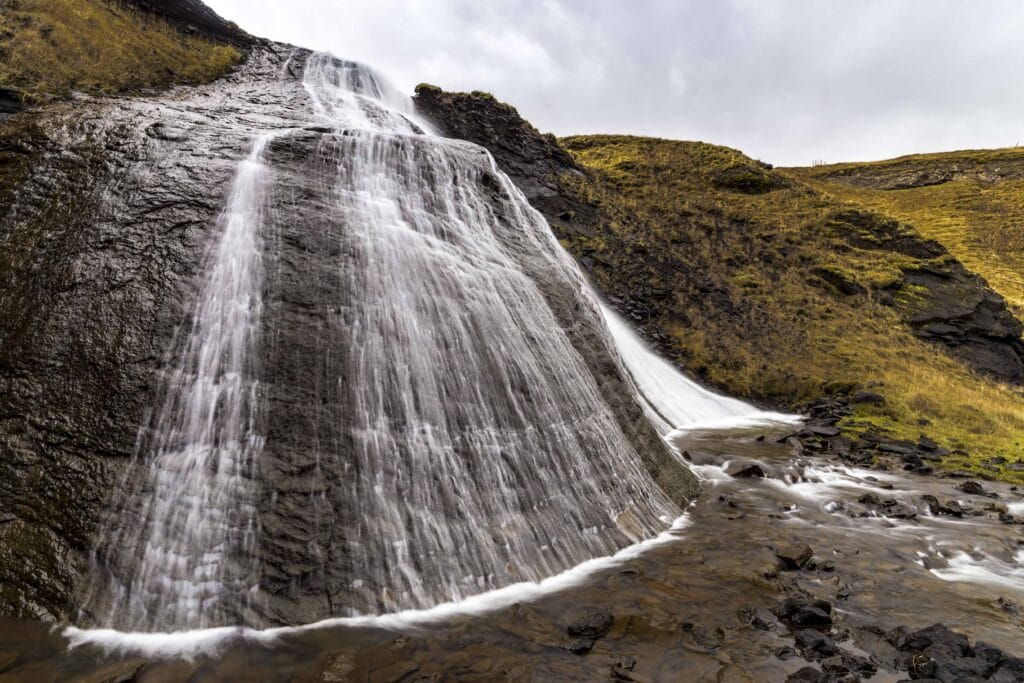
Imagine standing at the bottom of a huge almost-spherical boulder that is completely covered with a glimmering stream of water that is cascading down from above surrounded by lush green vegetation and dark-colored locks. Now imagine standing at the top of the waterfall and watching how it falls down to the ground. You can do both at Hvítserkur waterfall. The waterfall shares its name with the better-known monolith in the area – Hvítserkur rock that often seems to resemble an animal like rhinoceros or an elephant, located on the Vatnsnes peninsula which is quite a popular spot. The Icelandic name Hvítserkur translates to a long white skirt in English which is quite suited to the way the waterfall looks.
One can visit the waterfall two ways – up the gully from where it falls down and from the bottom of the gully where the water transcends into a calm stream. You will first approach the waterfall from the top so you will have to climb down to see it from the other perspective. The hike down is fairly easy. Even though the surrounding areas of the waterfall are mountain-dominated, you will find many beautiful flowers near the foot of the waterfall along with beautiful green grass. The serenity of this place is completely on another level and you will most likely find yourself all alone exploring this charming and peaceful location.
Lambafellsgja Fissure
Remember the mysterious dark pathways in-between two huge rocks or mountains that you often get to see on TV? The Lambafellsgja fissure is exactly like those pathways that you so often see on the television. Lambafellsgja is a deep, narrow fissure in a small hill in the Lambafell landscape which is a heavy mountain area in the highlands. The southern side of the fissure is filled with a high-temperature active steam vent which can be a great natural sight to witness. The fissure is about 50 meters deep and a great place to go on a hike as it is also safe to bring children on this trip. The best time to hike in this fissure is in the summer season.
Taking the southern route to get to the fissure will be a smart choice. The slope is steep with made of loose gravel. The northern end of the fissure rises and opens at a level on par with the surroundings. So, you can either hike back to the south or end the trip there. There beautiful outcrops on the fissure along with subglacial basalt pillows which allegedly may have formed during the glacial period that preceded the last one. If you drive to this fissure you will have to park your vehicle at a parking spot near Keilir which is about one kilometer away from Lambafellsgja. You can take the hike from there and reach the fissure on foot.
Selvallafoss

Located in the western part of Iceland in Snæfellsnes peninsula, Selvallafoss waterfall is a hidden waterfall which is also known as the Sheep’s waterfall. This beautiful hidden waterfall falls of several different steps with the first step being the tallest. The fall is surrounded by a lot of herbs and shrubs along with the dark-colored rocks and such giving the whole landscape a nice, rustic vibe of silent natural scenery. The first drop of the waterfall is about 35 feet which is the longest one followed by a more spread-out fall of about 11 meters and the third one with a height of 17 meters. There is a high possibility that you will find herds of sheep grazing in the fields above the waterfall which is quite a sight with a countryside vibe to it. This is probably why the waterfall may have gotten its name – ‘Sheep’s waterfall’. Like most waterfalls in Iceland, the scenery around the Selvallafoss waterfall is completely different in all seasons. While the summers have a greener and earthlier look to it, come winters and the landscapes transform into a snow wonderland with electric blue and white water pouring down the cliff.
Stakkholtsgjá Canyon

If you are in Iceland to find the real meaning of thrill, then Stakkholtsgjá canyon is one of those must-visit places that need a space in your traveling list. A 100-meter-deep and about 2 kilometers long, this canyon is located near the Þórsmörk valley and that’s where the 1.5-hour-long hike starts. Once you are through with the hike that comes with challenging but fun activities like jumping over rocks, walking through a river to cross them, and following a very narrow trail, you will come face to face with a small yet extremely beautiful waterfall. As you get closer to the waterfall, the trail will get narrower and narrower which is all the more exciting as you can hear the waterfall louder and louder as you move forward.
There is a chance that you may slip and fall into the water at some point but trust us, it is more fun than dreadful. It is smart to wear water and windproof shell clothing on the outside to stay safe and warm inside. You will find that the rocks around you in the canyon are covered with bright green moss and other kinds of vegetation. A cherry on top, Stakkholtsgjá canyon has also served as a filming location among many others in Iceland. You will need a sturdy 4×4 vehicle to drive to the canyon since the landscape in the highlands is very tricky and there are often rivers in your path that need crossing.
Ófærufoss Waterfall

This is just the place for you to visit if seeing some of the most amazing waterfalls in Iceland is on your list along with making way to some of the most exclusive locations in the country which are very difficult to reach. Ófærufoss waterfall is also known as the ‘impassable waterfall’ which generates from Nyðri-Ófæra river – the ‘impassable northern river’ of the highlands. Located in Eldgjá canyon, the canyon of fire, the waterfall is easily one of the top fifteen waterfalls in Iceland. Canyon Eldgjá is an eruptive fissure that is spread across an area of 40 kilometers and was formed during the time Vikings settled in the country.
Pure-white water falling from in-between the black and dark brown colored rocks, Ófærufoss waterfall is absolutely stunning. The landscape is completely covered in lush green vegetation. It is only accessible from June to September. The waterfall falls through multiple steps and the lowest one used to have a beautiful stone arch built over until 1993 which is when it was destroyed in a natural spring thaw. Reaching this waterfall requires you to cross a river so make sure that you travel in a 4×4 sturdy vehicle. There is going to be two or two-and-a-half-kilometer long walk to the waterfall so don’t forget to put on your nice hiking shoes.
Múlagljúfur Canyon

Another canyon with incredible and uncanny beauty, Múlagljúfur canyon is formed with steep rocks and beautiful green vegetation along with two gorgeous waterfalls and a glacial river that flows below in the canyon. The river gets it to water from the nearby Öræfajökull glacier which is a part of the Vatnajökull glacier, Iceland’s and Europe’s largest glacier. The view from atop the canyon is simply amazing. You can not only see all that the canyon has to offer down below but also the two beautiful glacier lagoons in the distance.
The canyon is located near the village Hof and the Fjallsárlón glacier lagoon near the Ring Road and is quite difficult to access which explains the reason why it is a secret location. You will have to take the access road and head west. After traveling for about 3-4 kilometers, you will see the parking lot for the canyon. The trail from there will take you to the top of the canyon and from there you can start with the hike.
Klifbrekkufossar

A country which is famous for powerful rivers, glaciers, volcanoes, and waterfalls, it is fitting for it to have a waterfall that falls of from 7 different slopes and hence justifies the nickname – Klifbrekkufossar: the sever-tiered waterfall. Located in the eastern part of the country in Mjóifjörður fjord, Klifbrekkufossar is a 90-meter-high waterfall that can be enjoyed from the bottom standing a little bit further from the foot. The waterfall gets its water from a spring-fed river named Fjarðará which means that water is very pure, free from all kinds of impurity.
The literal meaning of the name Klifbrekkufossar is ‘climbing slope waterfalls’ which would be quite fitting if you see it from a distance. It seems as if the waterfall is climbing the slopes of the mountain instead of cascading like waterfalls generally look like. It is accessible only from June to September since the mountain pass that leads to the waterfall is closed off in the winters as the road that goes down to it passing through the narrow fjord is very difficult to drive through when the weather is not pleasant.

